Virtual reality training significantly enhances athletic performance by providing immersive environments for skill development. This article explores the effectiveness of VR training, its psychological benefits, and user experiences across different regions. Key technologies such as Oculus Rift and HTC Vive are examined, along with emerging trends like AI integration and gamification. Challenges faced by athletes in adopting VR training are also discussed, highlighting the varying perceptions based on technological accessibility.
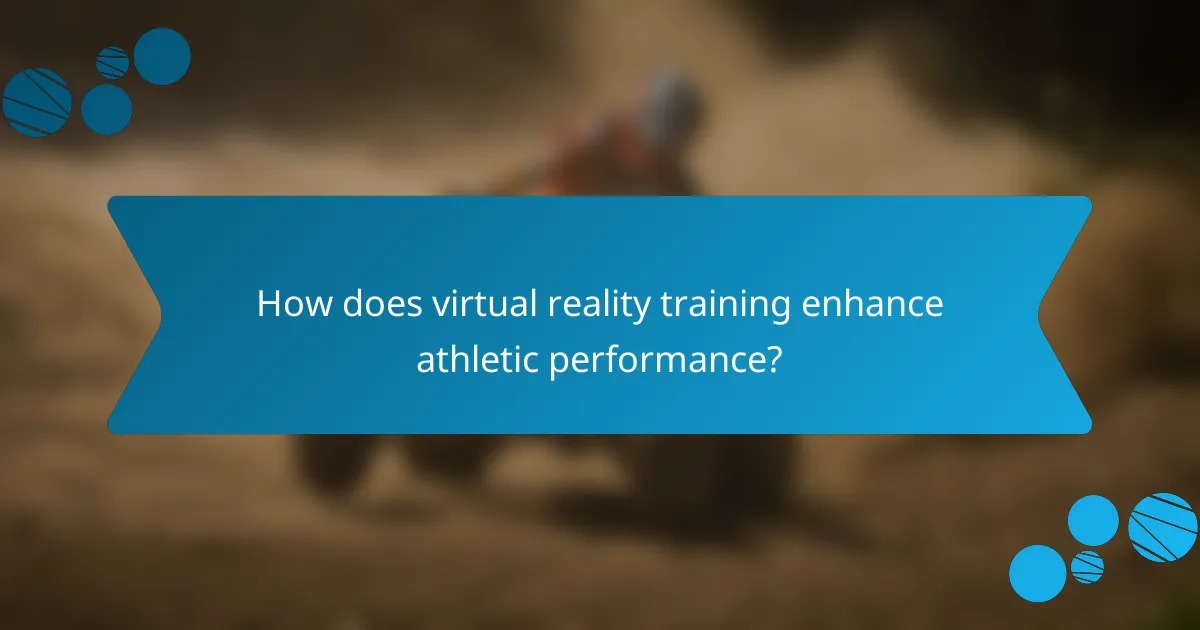
How does virtual reality training enhance athletic performance?
Virtual reality training significantly enhances athletic performance by providing immersive, interactive environments for skill development. Athletes can practice techniques, improve decision-making, and simulate game scenarios without physical limitations. This technology allows for personalized feedback, which accelerates learning and retention. Studies indicate that athletes using VR training can improve reaction times by up to 20%, showcasing its effectiveness in honing performance skills. Enhanced visualization and mental conditioning through VR contribute to better focus and confidence during actual competition.
What are the key benefits of using virtual reality in sports training?
Virtual reality enhances sports training by providing immersive experiences, improving skills, and boosting performance. Key benefits include increased engagement, enhanced decision-making, and the ability to simulate real-game scenarios. Athletes can practice in a safe environment, reducing injury risks while refining techniques. Research indicates that VR training can lead to a 30% improvement in reaction times and a 25% increase in overall performance metrics.
How does immersion impact skill acquisition in athletes?
Immersion significantly enhances skill acquisition in athletes by creating realistic training environments. Virtual reality training engages multiple senses, improving motor skills and decision-making. Studies show that immersive experiences lead to better retention and transfer of skills in real-world scenarios. Athletes report increased confidence and reduced anxiety when practicing in virtual settings, making it a valuable tool for performance enhancement.
Which sports are most effectively enhanced by virtual reality training?
Virtual reality training effectively enhances sports such as basketball, football, soccer, tennis, and golf. These sports benefit from improved decision-making, spatial awareness, and reaction times through immersive simulations. For example, basketball players can practice shooting and defensive strategies in a virtual environment, leading to better performance on the court. Soccer players enhance their tactical understanding and positioning, while golfers refine their swing mechanics. Virtual reality’s ability to replicate real-game scenarios provides athletes with a unique training advantage.
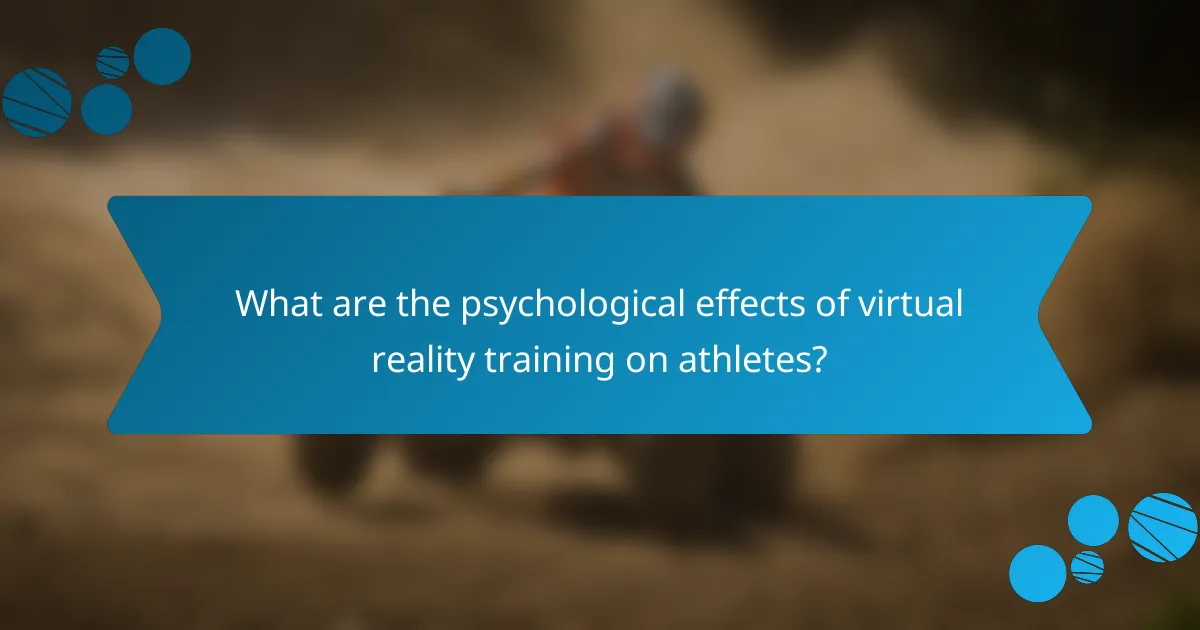
What are the psychological effects of virtual reality training on athletes?
Virtual reality training positively impacts athletes’ psychological states by enhancing focus, reducing anxiety, and improving confidence. This immersive experience allows athletes to visualize performance scenarios, which can lead to better mental preparedness. Research indicates that athletes using VR report increased motivation and reduced performance anxiety. Additionally, VR can simulate high-pressure situations, enabling athletes to practice coping strategies effectively.
How does virtual reality influence motivation and focus during training?
Virtual reality enhances motivation and focus during training by creating immersive environments. These environments engage athletes, making practice sessions more enjoyable and effective. Research shows that VR can increase attention span and reduce distractions, leading to improved skill acquisition. Additionally, athletes report higher levels of motivation when using VR, as it simulates real-game scenarios and provides immediate feedback.
What role does virtual reality play in injury rehabilitation for athletes?
Virtual reality plays a significant role in injury rehabilitation for athletes by enhancing recovery through immersive simulations. It allows athletes to engage in sport-specific movements safely, reducing the risk of re-injury. Studies show that VR training improves motivation and adherence to rehabilitation programs, leading to faster recovery times. Additionally, VR can simulate real-game scenarios, enabling athletes to regain confidence and mental readiness as they return to their sport.
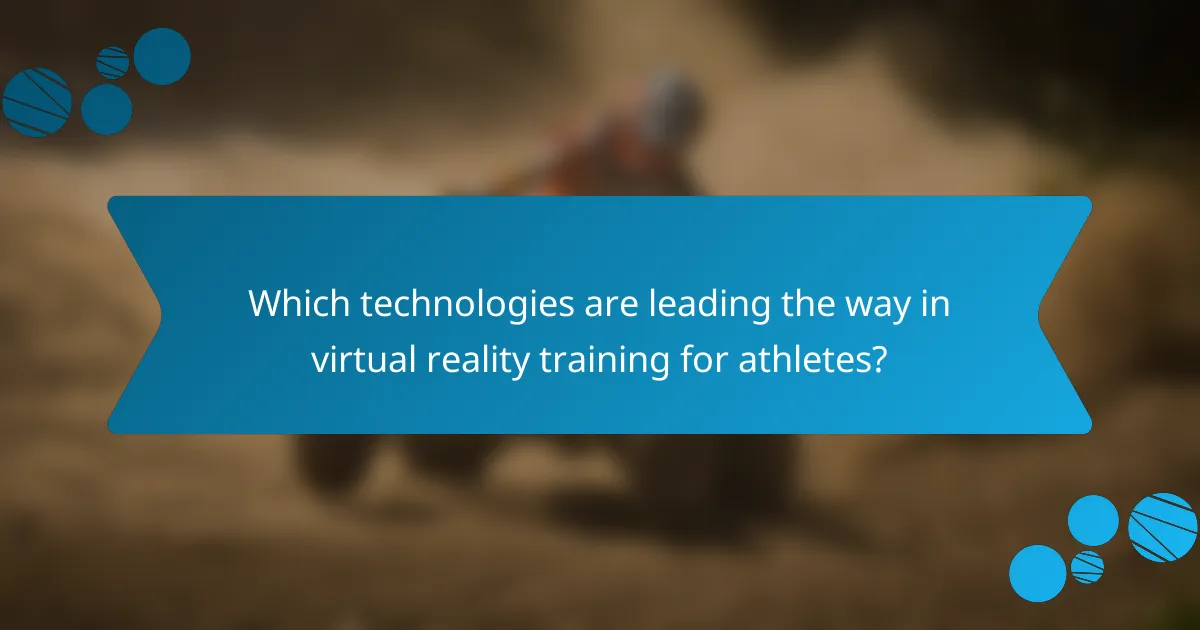
Which technologies are leading the way in virtual reality training for athletes?
Leading technologies in virtual reality training for athletes include Oculus Rift, HTC Vive, and PlayStation VR. These platforms enhance performance through immersive simulations and feedback mechanisms.
Oculus Rift offers high-resolution visuals and precise motion tracking, making it ideal for skill development. HTC Vive provides room-scale experiences, allowing athletes to move freely and interact with their environment. PlayStation VR is accessible and integrates well with existing gaming systems, appealing to a broader audience.
Recent studies show that athletes using VR training improve reaction times by up to 30%. This technology enables tailored training sessions that focus on individual needs, enhancing overall effectiveness. User experiences highlight increased engagement and motivation through gamified training scenarios.
What are the most popular virtual reality platforms used in sports?
The most popular virtual reality platforms used in sports include Oculus Rift, HTC Vive, PlayStation VR, and Valve Index. These platforms enhance training effectiveness through immersive simulations, allowing athletes to practice skills in realistic environments. User experiences highlight increased engagement and improved performance metrics. Each platform offers unique features, such as advanced motion tracking and social interaction capabilities, catering to various athletic training needs.
How do hardware and software choices affect training outcomes?
Hardware and software choices significantly influence the effectiveness of virtual reality training for athletes. High-quality hardware enhances immersion and realism, while advanced software provides tailored training programs and analytics.
Effective virtual reality training relies on powerful graphics processing units (GPUs) and motion tracking systems. These components deliver realistic simulations, allowing athletes to practice in lifelike environments. Software that adapts to individual performance metrics can optimize training outcomes, enabling athletes to focus on specific skills or weaknesses.
User experiences vary based on the integration of these technologies. Athletes using high-end systems report improved engagement and motivation. In contrast, those with lower-quality setups may experience limitations in training effectiveness.
Ultimately, the synergy between hardware and software determines how well virtual reality training meets athletes’ needs, impacting their performance and development.
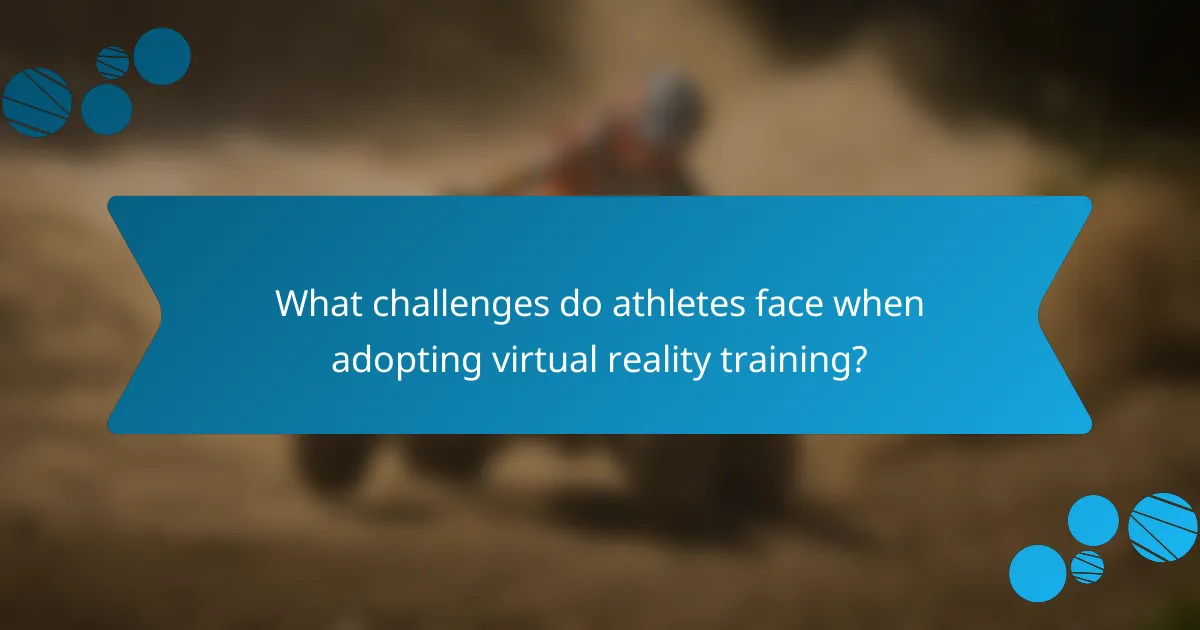
What challenges do athletes face when adopting virtual reality training?
Athletes face several challenges when adopting virtual reality training. Key issues include the high cost of equipment, potential motion sickness, and the need for technical expertise. Additionally, a lack of standardized protocols may hinder effective training integration. User experience can vary greatly, affecting overall effectiveness.
How can technical issues hinder the effectiveness of virtual reality training?
Technical issues can significantly undermine the effectiveness of virtual reality training for athletes. Problems such as software glitches, hardware malfunctions, and connectivity issues can disrupt the training experience. These disruptions may lead to inconsistent data collection and hinder performance analysis, which are crucial for improving athletic skills. Additionally, if the virtual environment is not stable, athletes may struggle to engage fully, reducing the overall impact of the training. Ensuring reliable technology is essential for maximizing the benefits of virtual reality training.
What are common user experiences and feedback regarding virtual reality training?
Common user experiences with virtual reality training for athletes highlight significant effectiveness and positive feedback. Users report enhanced focus, improved skill retention, and increased engagement compared to traditional training methods. Many athletes appreciate the immersive environment, which simulates real-game scenarios, allowing for practical application of techniques.
Feedback often emphasizes the technology’s ability to provide immediate performance analysis, enabling athletes to make quick adjustments. Users also note the accessibility of training sessions, as VR allows for practice without the need for physical space or equipment. Overall, athletes find virtual reality training a valuable tool for enhancing their performance and preparation.
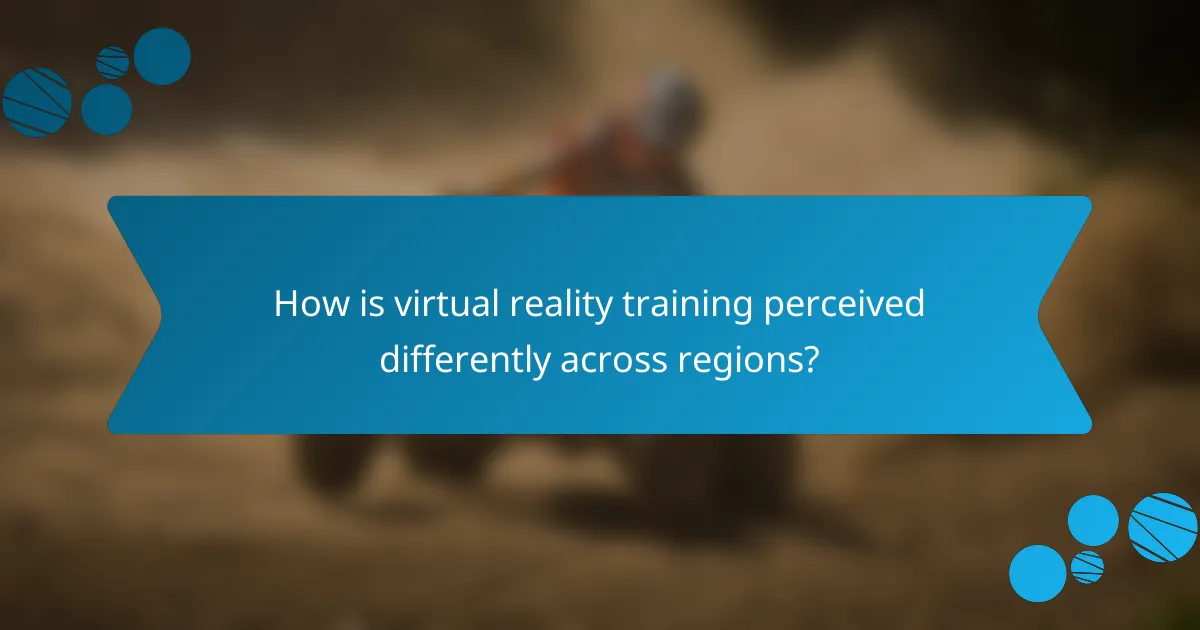
How is virtual reality training perceived differently across regions?
Virtual reality training for athletes is perceived differently across regions due to cultural attitudes and technological accessibility. In regions with advanced technology infrastructure, such as North America and Western Europe, athletes often embrace virtual reality training as an innovative tool for enhancing performance. They report significant benefits, including improved focus and skill acquisition. In contrast, regions with limited access to technology may view it as a luxury rather than a necessity, leading to skepticism about its effectiveness. User experiences vary widely, reflecting these regional differences, with some athletes praising the immersive nature of training while others express concerns about costs and practicality.
What cultural factors influence the adoption of virtual reality training in sports?
Cultural factors significantly influence the adoption of virtual reality training in sports. These factors include societal attitudes towards technology, access to resources, and the value placed on innovation in training methods.
In cultures that embrace technological advancements, athletes and organizations are more likely to invest in virtual reality training. For example, countries with strong tech industries often lead in adopting such innovations. Conversely, in cultures where traditional methods dominate, there may be resistance to integrating virtual reality.
Access to resources also plays a critical role. Regions with better funding for sports and technology can implement virtual reality training more effectively. Additionally, the perceived benefits of virtual reality training, such as enhanced performance and injury prevention, are crucial in shaping cultural acceptance.
Lastly, the influence of role models and success stories can motivate athletes and coaches to adopt virtual reality training. When prominent athletes endorse and utilize these technologies, it encourages wider acceptance and integration into training regimens.
How do regional preferences shape the design of virtual reality training programs?
Regional preferences significantly influence the design of virtual reality training programs for athletes. Programs are tailored to cultural norms, sports popularity, and training methodologies prevalent in specific regions. For example, athletes in regions with a strong focus on endurance sports may prioritize VR simulations that enhance stamina and technique. In contrast, areas emphasizing team sports might develop programs to improve communication and strategy among players. This customization ensures that training is relevant and effective, aligning with the specific needs and expectations of athletes based on their geographical context.

What future trends are emerging in virtual reality training for athletes?
Emerging trends in virtual reality training for athletes focus on enhanced realism, personalized experiences, and data analytics. These advancements improve skill acquisition and performance evaluation.
1. Increased use of artificial intelligence creates adaptive training environments tailored to individual athlete needs.
2. Integration of biometric feedback allows real-time adjustments to training regimens, enhancing effectiveness.
3. Collaborative virtual environments enable athletes to train with peers or coaches remotely, fostering teamwork.
4. Gamification elements are being incorporated to boost motivation and engagement during training sessions.
5. Enhanced motion capture technology provides detailed analysis of biomechanics, helping athletes refine techniques.
6. Accessibility improvements make VR training more affordable and available to a broader range of athletes.
How might advancements in technology reshape virtual reality training?
Advancements in technology will significantly enhance virtual reality training for athletes by improving realism and interactivity. Enhanced graphics and haptic feedback create immersive environments, allowing athletes to practice in lifelike scenarios. Additionally, real-time data analytics provide personalized feedback, optimizing performance. Wearable tech integration tracks biometrics, enhancing training effectiveness. As a result, athletes can refine skills more efficiently and safely.
What are expert predictions for the evolution of virtual reality in sports?
Expert predictions indicate that virtual reality training for athletes will become increasingly effective, offering enhanced benefits and user experiences. As technology advances, VR training is expected to provide more immersive simulations that improve skill acquisition and performance analysis. Athletes will likely experience greater engagement and motivation through personalized training environments that adapt to their unique needs. Moreover, the integration of real-time data analytics will enable tailored feedback, optimizing training efficiency and outcomes.
What best practices should athletes follow when integrating virtual reality into their training?
Athletes should prioritize specific best practices when integrating virtual reality into their training. First, they must ensure the technology aligns with their training goals. Second, they should gradually incorporate VR sessions to avoid cognitive overload. Third, regular assessments of progress and adaptation of VR scenarios are essential for maximizing effectiveness. Lastly, maintaining a balance between VR training and physical practice is crucial to optimize performance.